Dominion of India
| Dominion of India | ||||||||||
| भारत अधिराज्य | ||||||||||
| ||||||||||
| ||||||||||
| Anthem Jana Gana Mana Royal anthem God Save the King | ||||||||||
 | ||||||||||
| Capital | New Delhi | |||||||||
| Government | Constitutional monarchy | |||||||||
| Monarch | ||||||||||
| • | 1947–1950 | George VI | ||||||||
| Governor-General | ||||||||||
| • | 1947–1948 | Louis Mountbatten | ||||||||
| • | 1948–1950 | Chakravarthy Rajagopalachari | ||||||||
| Prime Minister | ||||||||||
| • | 1947–1950 | Jawaharlal Nehru | ||||||||
| Legislature | Constituent Assembly | |||||||||
| Historical era | Cold War | |||||||||
| • | Indian Independence Act | 15 August 1947 | ||||||||
| • | Indo-Pakistani War | 22 October 1947 | ||||||||
| • | Republican constitution adopted | 26 January 1950 | ||||||||
| Area | ||||||||||
| • | 1950 | 3,287,263 km² (1,269,219 sq mi) | ||||||||
| Currency | Indian rupee | |||||||||
| ||||||||||
The Dominion of India (Hindi: भारत अधिराज्य, Bhārata Adhirājya), also known as the Union of India, was a predecessor to the modern-day Republic of India and an independent state that existed between 15 August 1947 and 26 January 1950. It was transformed into the Republic of India by the promulgation of the Constitution of India on 26 January 1950.[1]
George VI was the king (the head of state) and was represented by the Governor-General of India. However, the governor-general was not designated viceroy, as had been customary under the British Raj. Two governors-general held office in India during the Dominion period (after the office of Viceroy was abolished by the Indian Independence Act 1947): Mountbatten of Burma (1947–48) and Chakravarti Rajagopalachari (1948–50). Jawaharlal Nehru held office as prime minister formerly as Secretary for State (the head of government) of the Union of India throughout this period.
Partition of India
The Partition of British India on 14/15 August 1947 led to the creation of two sovereign states, both dominions: Pakistan (which later split into the Islamic Republic of Pakistan and the People's Republic of Bangladesh) and India (later the Republic of India).
The Constituent Assembly adopted the Constitution of India, drafted by a committee headed by Dr Rajendra Prasad, on 26 November 1949. India became a federal, democratic republic after its constitution came into effect on 26 January 1950. Rajendra Prasad became the first President of India.
Monarchy
.svg.png)
The sovereign and head of state of the dominion of India was a hereditary monarch, George VI, who was also the sovereign of the United Kingdom and the other dominions in the British Commonwealth of Nations. His constitutional roles were mostly carried out by the Governor-General of India. The royal succession was governed by the Act of Settlement 1701.
The monarchy was abolished on 26 January 1950, when India became a republic within the Commonwealth, the first Commonwealth country to do so.
List of Indian monarchs
The King in relation to independent India held the following official style and titles:
- 15 August 1947 to 22 June 1948: His Majesty George the Sixth, by the Grace of God, of Great Britain, Ireland and the British Dominions beyond the Seas King, Defender of the Faith, Emperor of India[2]
- 22 June 1948 to 26 January 1950: His Majesty George the Sixth, by the Grace of God, of Great Britain, Ireland and the British Dominions beyond the Seas King, Defender of the Faith [3]
| House of Windsor | ||||||
| Portrait | Name | Birth | Death | Monarch From | Monarch Until | Relationship with Predecessor(s) |
|---|---|---|---|---|---|---|
 |
King George VI | 14 December 1895 | 6 February 1952 | 15 August 1947 | 26 January 1950 | Son of George V, Emperor of India |
List of Governors-General
| Name (birth–death) |
Picture | Took office | Left office | Appointer | |
|---|---|---|---|---|---|
| Governors-General of the Dominion of India, 1947–1950 | |||||
| The Viscount Mountbatten of Burma[4] (1900–1979) |
 |
15 August 1947 | 21 June 1948 | George VI | |
| C. Rajagopalachari (1878–1972) |
 |
21 June 1948 | 26 January 1950 | ||
See also
References and external links
- ↑ Winegard, Timothy C. (2011), Indigenous Peoples of the British Dominions and the First World War, Cambridge University Press, pp. 2–, ISBN 978-1-107-01493-0
- ↑ Heraldic.org website
- ↑ The London Gazette: no. 38330. p. 3647. 22 June 1948. Retrieved 25 August 2014. Royal Proclamation of 22 June 1948, made in accordance with the Indian Independence Act 1947, 10 & 11 GEO. 6. CH. 30. ('Section 7: ...(2) The assent of the Parliament of the United Kingdom is hereby given to the omission from the Royal Style and Titles of the words "Indiae Imperator" and the words "Emperor of India" and to the issue by His Majesty for that purpose of His Royal Proclamation under the Great Seal of the Realm.')
- ↑ Created Earl Mountbatten of Burma on 28 October 1947.
| Wikimedia Commons has media related to Partition of India. |

.jpg)